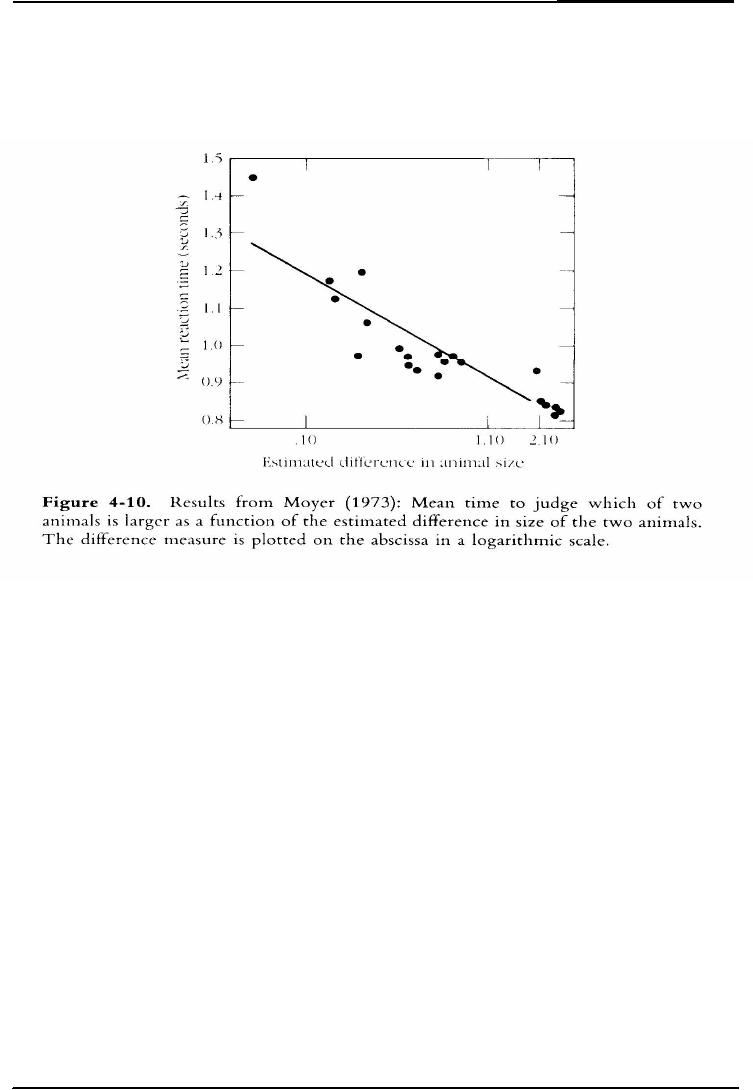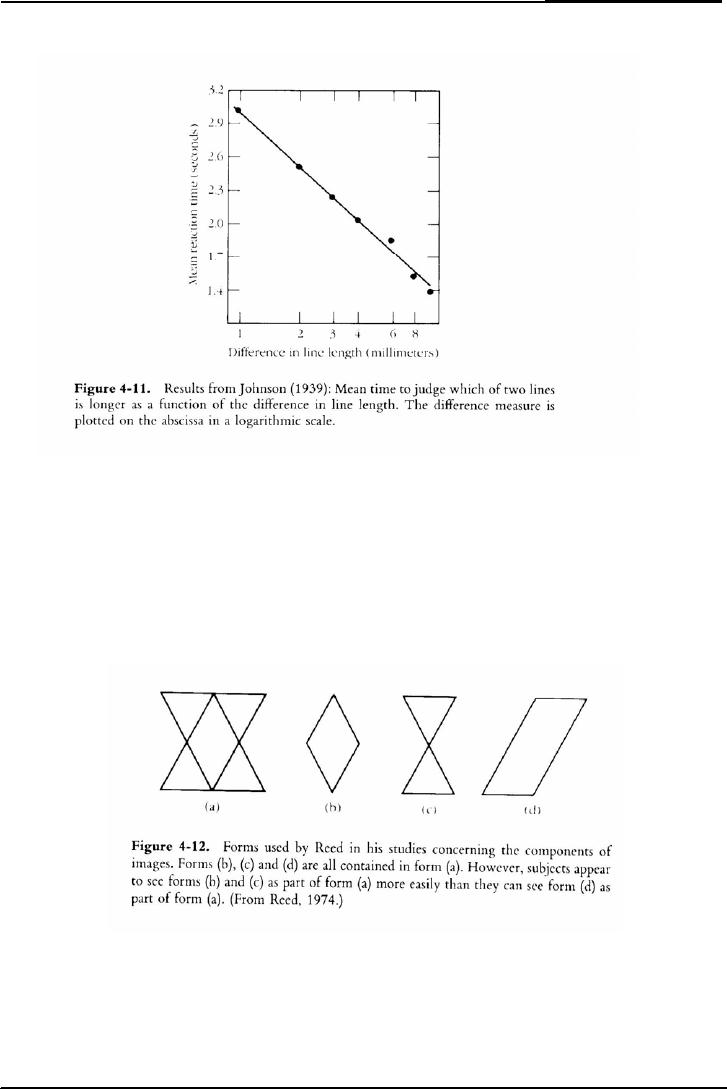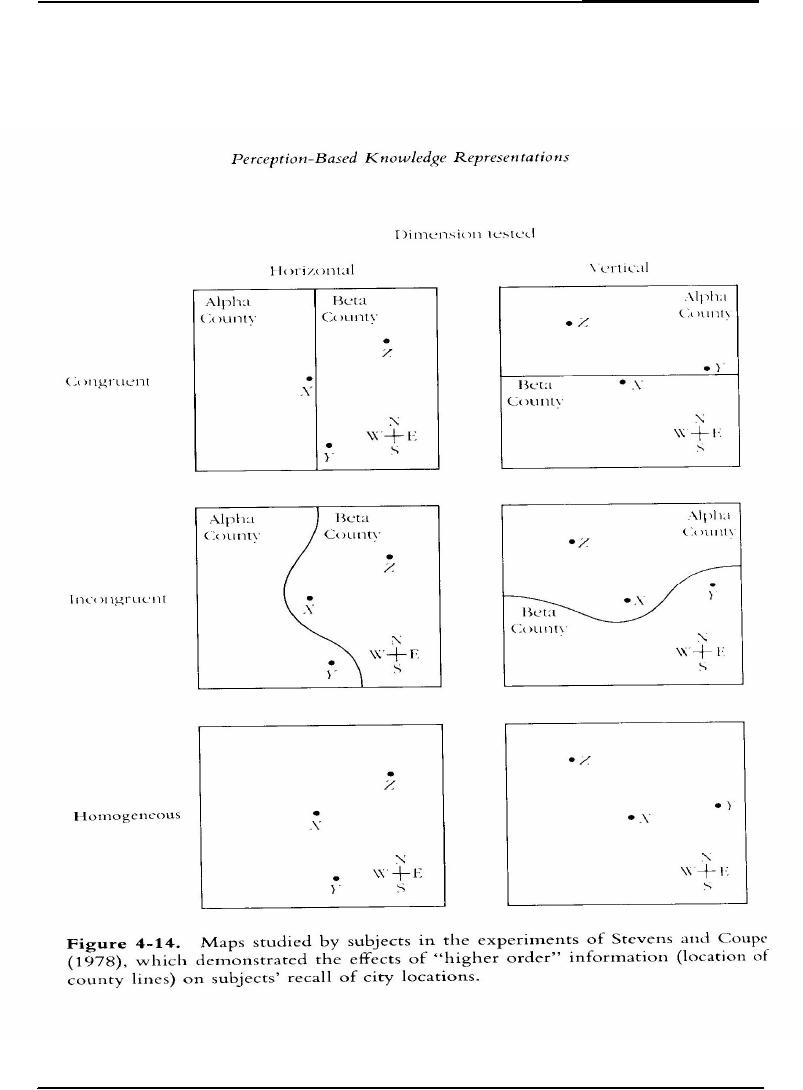 |

Cognitive
Psychology PSY 504
VU
Lecture
41
Memory
Mental
Imagery
Images
are tools of
thinking.
Many
times when we are thinking
about a scene an object no
longer present, we experience
an
image
of that scene or object.
People often refer to this
as "Seeing in one's mind".
The important
question
in mental imagery is,
What
is the nature of knowledge
representations that underlie
mental imagery?
These
representations are called
mental images. Much of this
research has been concerned
with
the
types of mental processes
that can be performed on
spatial images.
More
evidence
A
very different sort of data
for the difference between
spatial and linear
representations comes
from
the research of Roland &
Friberg (1985). They had
subjects either mentally
rehearse a word
jingle
or mentally rehearse finding
their way from their
house and around streets in
their
neighborhood.
They
measured changes in blood
flow in various parts of the
cortex. It is apparent that
different
neural
regions are involved when we
process verbal versus
spatial information. Moreover
these
appear
to be the regions that are
involved in the actual
processing of spoken and
seen material.
The
occipital and temporal areas
involved in the route
finding task are the
same areas involved
in
vision.
They gave these three
tasks, mental arithmetic,
memory scanning of a musical
jingle,
imaging
a walk. And they concluded
that visual cortex increase
in blood flow but not
for mental
arithmetic
or music
Goldenberg
and colleagues (1987)
Subjects
learned words by either
listening to them or forming
visual images to represent
them.
Recall
was better for imagery
group. More blood flow to
occipital lobe for imagery
group. Occipital
has
lot of vision areas.
Kosslyn
yet again
He
mentioned in his book `Image
and the Brain" at The
Resolution of the Imagery
Debate (1994)
that
Visual Buffer is where the
image is projected. Attention
window selects part of image
in the
buffer
for detailed processing.
When we recall the image
and realize it is decided by
attention
window.
Image
Comparison
Moyer
in 1973 conducted an experiment. He
was interested in they speed
with which subjects
could
judge the relative size of
two months animals from
the memory. For example,
which is
bigger
lion or Wolf? Which is
bigger lion or mouse? Many
people report that in making
these
121

Cognitive
Psychology PSY 504
VU
judgments,
particularly for the items
that are similar in size,
they experience images of
the two
objects
and seem to compare the
size of the objects in their
image. Moyer also asked to
estimate
the
absolute size of these
animals
Results
He
plotted the reaction time
for making a mental-size-comparison
judgment between two
animals
as
a function of the difference
between the two animal
estimated sizes. In general,
the judgment
times
decrease as the difference in
estimated size increases.
The graph shows that a
fairly linear
relation
exists between the scale on
the abscissa and the
scale on the ordinate. Thus,
the linear
relationship
in the figure means that
increasing the size
difference has a diminishing
effect on
reaction
time.
Visual
comparison
Line
comparison
Significantly
very similar results are
obtained when subjects make
comparisons of actual
physical
magnitudes.
Johnson (1939) had subjects
judge which of two
simultaneously presented
lines
were
longer.
Results
The
graphs plot subjects'
judgment time as a function of
the log difference in the
line length.
Again
a linear relation is obtained. It is
reasonable to except perceptual
judgments to take
longer
the
more similar the quantities
being compared are, since
discriminating accurately is
more
difficult
in such circumstances. The
fact that similar functions
are obtained when mental
objects
are
compared indicates that
making mental comparison
involves difficulties of
discrimination
similar
to those involved in perceptual
comparisons.
122

Cognitive
Psychology PSY 504
VU
Hierarchical
Structure of images
Complex
images tend to be organized
into pieces where each
piece represents part of the
whole
structure.
Reed (1974) showed subject
complex images and asked
them to hold images of
the
forms
in their minds. Then the
form was removed and
they were showed parts of
the image to
see
if they would recognize
them.
Subjects
were able to identify forms
(b) and (c) as parts of
form (a) 65 percent of the
item but
were
successful with form (d)
only 10 percent of the time.
The reason for the
difference was that
subject's
image of form (a) consisted
of parts such a forms (b)
and (c) but not
form (d).
Complex
images can be formed from a
hierarchy of a unit.
Mental
Maps
Subjects'
memory for maps appears to
have the hierarchical
structure associated with
spatial
images.
Consider your mental map of
the map of United States. It
is probably divided
into
regions,
and these regions into
states, and cities are
presumably pinpointed within
the states.
123

Cognitive
Psychology PSY 504
VU
Stevens
and Coupe were able to
demonstrate an experiment. There
were imagery Alpha
and
Beta
Counties, X and Y cities. Is X
east or west of Y? is X north or
south of Y?.
Subjects
were in error 18 percent of
the time on the X-Y question
for the congruent maps
and 15
percent
for the homogenous maps,
but they were in error 45
percent of the time for
the
124

Cognitive
Psychology PSY 504
VU
incongruent
maps. The figure is given
below.
Subjects
were using information about
the location of the counties
to help them remember the
city
locations.
This reliance on higher
order information led them
to make errors; just as
similar
reasoning
can be lead errors in
questions about North
American geography.
An
image can not be a picture
but the distinctions between
them can be frustratingly
subtle. We
can
perform operations on images,
such as scanning, which we
also can on pictures.
However, it
appears
that there may be two
image systems, one that
contains the continuasouly
varying and
the
one that contains the
spatial information.
Two
types of imagery
Research
such as that just reviewed
lends support to the view
that imagery is spatial but
not
visual
in character. Farah and
colleagues (1988) have made
suggestion that there might
be two
kinds
of imagery, one that
involves visual properties
and one that involves
spatial properties.
Two
types are:
Visual
properties
Visual
properties involve recognition of
visual objects and patterns
seemed to be
performed
in the temporal lobe.
Spatial
properties
Spatial
tasks such as location. They
argued that imagery tasks
that require access
to
visual
details will be performed in
the temporal region and
will show modality
specific
effects.
Evidence
They
gave some evidence
that;
Patient
with temporal damage
Problems
with color
Problems
with sizes
Problems
with shapes
The
patients were OK with mental
rotation, with image
scanning, and with
locations.
Size
and detail
Some
psychologists wanted to know
whether the image size
can be changed because of
visual
screen.
In there experiment, Subjects
were asked to picture an
elephant. Then asked to
picture a
rabbit
next to the elephant. Later
subjects were asked to
picture a rabbit standing
next to a fly.
Subjects
took longer to see the
features in a rabbit standing
next to the elephant than on
the on
standing
next to a fly.
Implications
Our
Mind's screen is somewhat
similar to a TV screen in that it
has a limited capacity. If a
large
elephant
fills the screen than
the rabbit's image has to be
small for it to be accommodated
next to
the
elephant. When the rabbit is
next to the fly, the
screen is available for a
large rabbit.
More
on size and
detail
Next
group was asked to picture a
giant rabbit standing next
to a tiny elephant. And then
they
were
showed a tiny rabbit
standing next to a giant
fly. This time they
took longer to report
features
on rabbit next to the fly.
This was done to ensure
that subjective differences in
images
are
accounted for.
Implications
This
seems to confirm the idea
that images are screened in
a similar fashion to TV or
cinema
screens
for that matter.
125

Cognitive
Psychology PSY 504
VU
People
are different
Some
psychologist say there is no
imagery but some say
images are present.
Sir
Francis Galton (Darwin's
cousin) worked on imagery. In
1883 he asked people to
describe
various
features of their breakfast
table. He found that a large
number of people reported
no
imagery.
These people were
professional and
intelligent.
The
result of Galton was
challenged. And a study published in
1965 tested Mensa members.
97%
reported
vivid imagery.
Imagers
vs. verbalizers
Images
and linguistic things are
very different.
Visual
imagers show more regular
breathing patterns than
verbalizers when working
out
problems.
This could be because
verbalizers use sub vocal
speech.
But
there is not much breathing
in vision.
Imagery
is not simple
It
may be simplistic to assume
that imagery is either
present or absent. Some
people may be
better
than others in using imagery
for recall. Others may be
able to better manipulate
images to
solve
problems. Yet others may be
better than others to
generate new images for
creative
purposes.
Eidetic
Imagery
Eidetic
Imagery refers to people's
ability to see an image that
is a perfect representation. If
you
see
a picture of a room with 12
chairs but you didn't
count them at the time.
Asked to look at the
image
of the room and count
the chairs in it, those
with eidetic imagery can do
a perfect count.
Anees
A. Shaikh, a Pakistani psychologist in
the USA has done a lot of
pioneering work on
eidetic
images
126
Table of Contents:
- INTRODUCTION:Historical Background
- THE INFORMATION PROCESSING APPROACH
- COGNITIVE NEUROPSYCHOLOGY:Brains of Dead People, The Neuron
- COGNITIVE NEUROPSYCHOLOGY (CONTINUED):The Eye, The visual pathway
- COGNITIVE PSYCHOLOGY (CONTINUED):Hubel & Wiesel, Sensory Memory
- VISUAL SENSORY MEMORY EXPERIMENTS (CONTINUED):Psychological Time
- ATTENTION:Single-mindedness, In Shadowing Paradigm, Attention and meaning
- ATTENTION (continued):Implications, Treisman’s Model, Norman’s Model
- ATTENTION (continued):Capacity Models, Arousal, Multimode Theory
- ATTENTION:Subsidiary Task, Capacity Theory, Reaction Time & Accuracy, Implications
- RECAP OF LAST LESSONS:AUTOMATICITY, Automatic Processing
- AUTOMATICITY (continued):Experiment, Implications, Task interference
- AUTOMATICITY (continued):Predicting flight performance, Thought suppression
- PATTERN RECOGNITION:Template Matching Models, Human flexibility
- PATTERN RECOGNITION:Implications, Phonemes, Voicing, Place of articulation
- PATTERN RECOGNITION (continued):Adaptation paradigm
- PATTERN RECOGNITION (continued):Gestalt Theory of Perception
- PATTERN RECOGNITION (continued):Queen Elizabeth’s vase, Palmer (1977)
- OBJECT PERCEPTION (continued):Segmentation, Recognition of object
- ATTENTION & PATTERN RECOGNITION:Word Superiority Effect
- PATTERN RECOGNITION (CONTINUED):Neural Networks, Patterns of connections
- PATTERN RECOGNITION (CONTINUED):Effects of Sentence Context
- MEMORY:Short Term Working Memory, Atkinson & Shiffrin Model
- MEMORY:Rate of forgetting, Size of memory set
- Memory:Activation in a network, Magic number 7, Chunking
- Memory:Chunking, Individual differences in chunking
- MEMORY:THE NATURE OF FORGETTING, Release from PI, Central Executive
- Memory:Atkinson & Shiffrin Model, Long Term Memory, Different kinds of LTM
- Memory:Spread of Activation, Associative Priming, Implications, More Priming
- Memory:Interference, The Critical Assumption, Limited capacity
- Memory:Interference, Historical Memories, Recall versus Recognition
- Memory:Are forgotten memories lost forever?
- Memory:Recognition of lost memories, Representation of knowledge
- Memory:Benefits of Categorization, Levels of Categories
- Memory:Prototype, Rosch and Colleagues, Experiments of Stephen Read
- Memory:Schema Theory, A European Solution, Generalization hierarchies
- Memory:Superset Schemas, Part hierarchy, Slots Have More Schemas
- MEMORY:Representation of knowledge (continued), Memory for stories
- Memory:Representation of knowledge, PQ4R Method, Elaboration
- Memory:Study Methods, Analyze Story Structure, Use Multiple Modalities
- Memory:Mental Imagery, More evidence, Kosslyn yet again, Image Comparison
- Mental Imagery:Eidetic Imagery, Eidetic Psychotherapy, Hot and cold imagery
- Language and thought:Productivity & Regularity, Linguistic Intuition
- Cognitive development:Assimilation, Accommodation, Stage Theory
- Cognitive Development:Gender Identity, Learning Mathematics, Sensory Memory